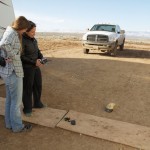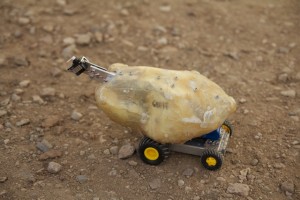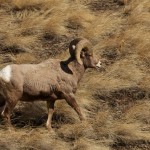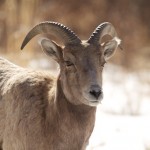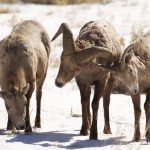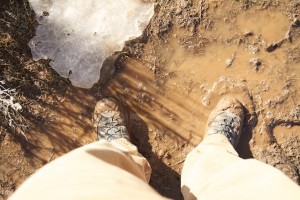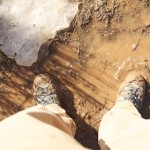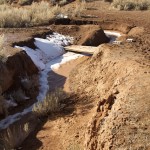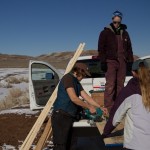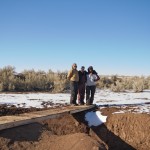After a lot of nailbiting on our part, our volunteer team of engineers shipped out the new robotic female grouse, and it arrived on Saturday. Right now it isn’t much to look at- other than the fiberglass resin shell in the shape of a taxidermy form, it is just a mobile assembly of circuit boards and wires right now. Gail has already done quite a bit to fix it up. She’s re-routed the power for the servos controlling body posture to get rid of some interference, and tucked much of the electronic guts inside the shell. We’ve also given the fembot a few test drives. We initially thought that the treads would be superior to the wheels in terms of maneuverability, but it turns out the added clearance from the wheels may be more important.
Cody Trip
Thursday I hopped in the Durango and headed down the road through Riverton and Thermopolis up to Cody, Wyoming. Some months ago I agreed to give a talk to the Meadowlark Audubon Society there. I started working on the talk when I got out here. This was one of the first popular talks on the sage-grouse work, and also the first talk I have ever given that goes into any detail on the conservation work from the Noise project. Thankfully I was able to pull slides from talks Jessica and Gail had given, and was able to put together what I think ended up a pretty good talk. The first section was on the fembot research, the second was on how grouse make sound, and then it ended on the noise impacts research. I managed to work in a few different videos, including a distant time-lapse of the lek, high-speed of a male display, and even “violation of the fembot.”
I think the talk itself was pretty well received. We were in the community room of a bank in Cody, and ended up with maybe ~40 people. I got a lot of great questions during and after the talk, and didn’t end up leaving until almost 2 hours after I’d started talking. I’m looking forward to giving this talk again in the future.
Before heading back, I drove up the North Fork of the Shoshone River towards the east entrance of Yellowstone. That stretch of road is one of the most beautiful I’ve ever been on: snowy range past a large frozen reservoir, vertical bundles of postpile, convoluted crags, a river cutting through the snow… All of this was the backdrop for an incredible number of incredibly close bighorn sheep. On my first (and only other) trip up this road, we had seen fairly low on the slopes. On this trip, I saw over 100, many right next to or even on the road. Most were in groups of around 20, with a mix of rams, ewes, and even a few lambs. I could have stayed for hours photographing these guys, but unfortunately I had to get back to Lander.
Full Moon Fever
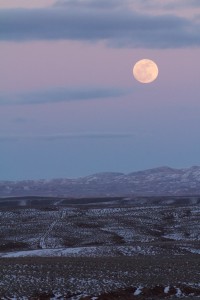 We get to study the sage-grouse in a really beautiful place here in Wyoming, and at no time is that more evident than during the full moon. There’s just something about seeing a moonrise over a vast expanse of sage, or watching the moon set over the snow-topped Wind River Range that just gives me chills. It’s always disappointing when we get cloudy weather on those days, but for this cycle in early March 2012, we were lucky enough to get stunningly beautiful moonrise and moonset. The moonset in particular was really magical- I was in a blind in the snow on Monument Lek. The birds on Monument had not really come in on any morning we were watching yet, but this morning Becca and I heard bird after bird fly in just as the moon started falling below the horizon. I’ve added a few more photos to the flickr albums- check out the Photos page for the links.
We get to study the sage-grouse in a really beautiful place here in Wyoming, and at no time is that more evident than during the full moon. There’s just something about seeing a moonrise over a vast expanse of sage, or watching the moon set over the snow-topped Wind River Range that just gives me chills. It’s always disappointing when we get cloudy weather on those days, but for this cycle in early March 2012, we were lucky enough to get stunningly beautiful moonrise and moonset. The moonset in particular was really magical- I was in a blind in the snow on Monument Lek. The birds on Monument had not really come in on any morning we were watching yet, but this morning Becca and I heard bird after bird fly in just as the moon started falling below the horizon. I’ve added a few more photos to the flickr albums- check out the Photos page for the links.
Readying Chugwater
Similar to last year’s season, Chugwater lek seems to be advanced by a few days compared with our two other focal leks (Monument and Preacher). Bird numbers have been reasonable for a few days, so we took advantage of a warm afternoon to set up our grid of stakes. Before starting the installation, I ran a few changes by Mary, our technician from last year and current Chugwater tape watcher back in Davis. She agreed on a few minor modifications from our otherwise excellently layed-out grid from 2011. First, we had tried to make one of the rows exactly straight on as viewed from the overlook hill. Straight girds make for easy observation, right? This turned out not to be the best idea, since it became extremely difficult to judge distance back-to-front on the grid. This year we slanted the middle row of stakes a little more, so they weren’t one immediately behind the other when viewed from the hill. The other two modifications involved shifting the stakes left and up-lek to try to make sure we could see the important ones better. We haven’t started taking video yet, but we hope these improvements will make reading positions easier both in the field and from the video. Always nice to learn something as we go on this project!
Grid installation day was EXTREMELY muddy- we all felt bad for our boots after that day.
We made another improvement- this time more by necessity than choice. Last year we constructed a short bridge over a gully so we could more easily carry gear up to the lek. This gully had evidently grown somewhat since last year, and our bridge barely fit (and where it did fit, it still left some quite slippery areas). Liz (on this years crew) led the effort to lengthen the bridge.
We have Grouse!
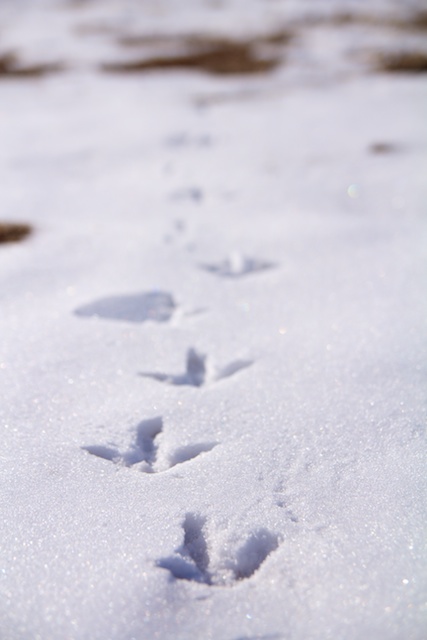 We have made a few quick visits to Chugwater and Monument Lek over the past couple of days. Reassuringly, we’ve found quite a bit of grouse sign at both leks. Gail and Becca even found 2 males strutting this morning. One of the males was banded, but we haven’t uncovered the band combination sheets yet to learn who he was. This is a much more promising start to the season than last year, where birds were few and far between, and we were considerably into March before the first males even showed up on Monument. This difference is almost certainly weather related; the snow level is a fraction of what it was last year.
We have made a few quick visits to Chugwater and Monument Lek over the past couple of days. Reassuringly, we’ve found quite a bit of grouse sign at both leks. Gail and Becca even found 2 males strutting this morning. One of the males was banded, but we haven’t uncovered the band combination sheets yet to learn who he was. This is a much more promising start to the season than last year, where birds were few and far between, and we were considerably into March before the first males even showed up on Monument. This difference is almost certainly weather related; the snow level is a fraction of what it was last year.
The camp is now pretty much set up. Gail fixed the hot water tank, and we’ve got heaters in the office trailer now. The rest of the crew comes tonight and tomorrow. We are even pretty sure the new robot bits will be delivered next week. There is always quite a bit of uncertainty at the beginning of the season; what will work and what won’t, and what plans are we going to have to change mid-stride in order to come away with as much data as possible. I’m sure we will still have many hurdles to clear, but so far, things are going relatively smoothly. (knock on wood!)

